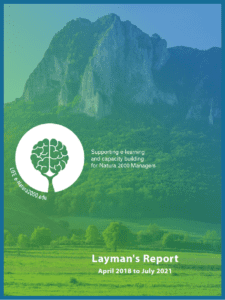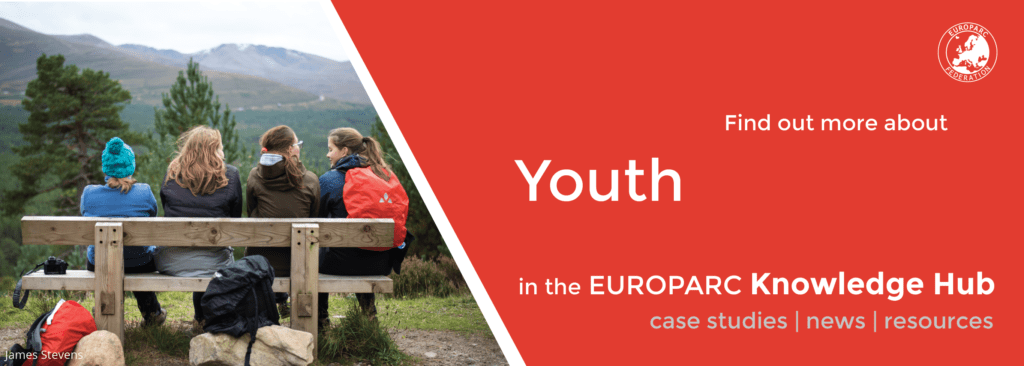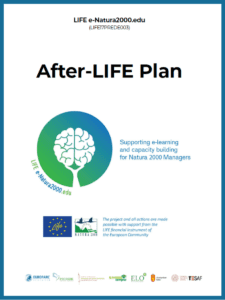LIFE e-Natura2000.edu: Layman’s report
The LIFE e-Natura2000.edu project’s overall goal was to demonstrate the need for and value of creating competence-based continuous professional development programmes directly linked to EU priorities for nature. Layman’s report presents the project’s experiences, main conclusions and a set of recommendations important for future competence-based learning initiative.
The main aim of the project was to produce and test a flexible mix of blended learning tools and methods, designed to build and develop the specific competencies required for effective Natura 2000 management practices.
The competence-based approach was central to the project’s capacity building objectives and applied to benefit more effective (stronger and improved) practical implementation of the Nature Directives.
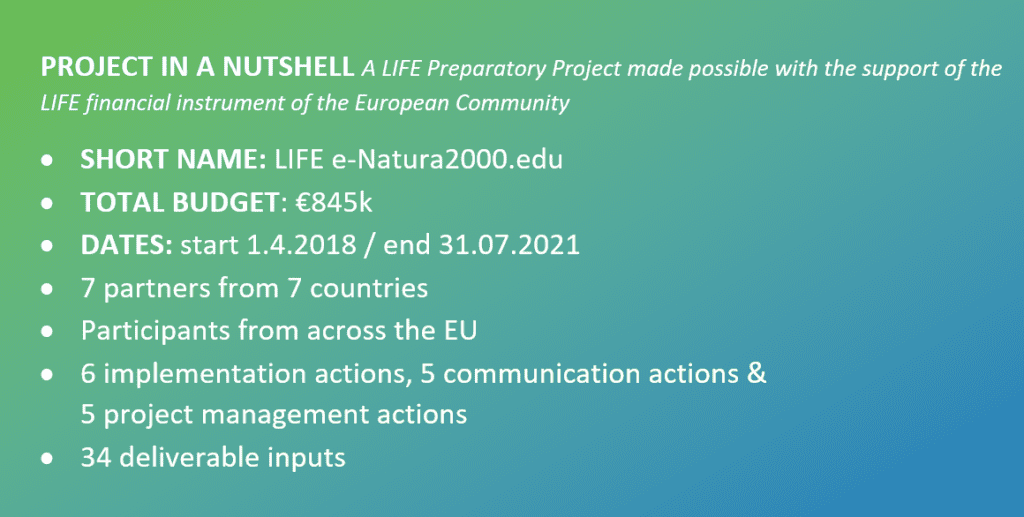
How LIFEedu worked
Project participants
A small group of 75 managers in both private and public sites were selected to join the project. Demand for places was high, but the project objectives were to work with a limited intake so that the tools and approaches could be thoroughly tested and evaluated.
As evidenced by the project evaluation results, all learning components and tools presented achieved very high levels of recommendation: participants’ feedback was extremely positive with 96% saying that they either are or were shortly planning to apply their learning in their work.
All the digital documents, presentations, references, videos have been very useful. I am already sharing and using them as working materials for other projects.
New tools
As a LIFE Preparatory project, a key goal for LIFEedu was to pilot its methods and tools and make results available to all interested in ways to improve the effectiveness of Natura 2000 management. Also, the project partners encouraged the core
group of participants to share their learning with their colleagues.
In addition, two specific actions were implemented to explore various means of broadening the circle of nature managers, professionals, stakeholders, and landowners potentially involved in the project: a specific Smartphone App and a university-based ‘Summer School’.
The ‘top three’ purposes for using the app are to:
> Find useful contents and inspiration;
> Improve knowledge about Natura 2000 and,
> Connect with peers
Training Needs Analysis tool
Another project action involved the development and testing of an online Natura 2000 Training Needs Analysis tool (the TNA). By using the purpose-built TNA, all individuals that have Natura 2000 management responsibilities can self-assess their training needs, generate a personal report and use the results to plan better their future professional development actions.
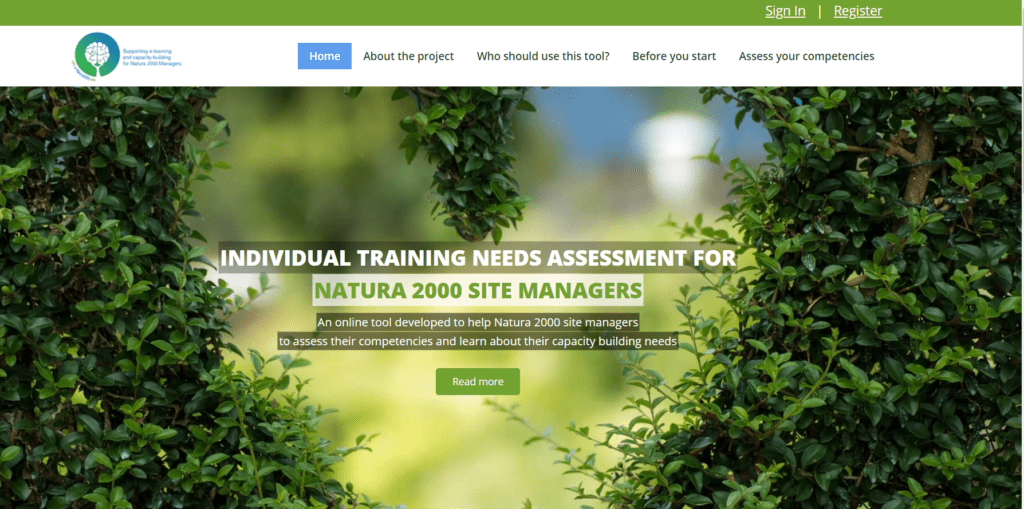
The online tool for Training Needs Assessment (TNA) is free for use and available here!
Project courses
The project designed three innovative capacity building courses in English, Spanish and Romanian using both online and face-to-face methodologies.
Participants’ feedback reveals the main project benefits as being:
- Refreshed knowledge and helped better understanding about Natura 2000’s role.
- Focus on personal competencies, in particular practical communication tools, techniques and approaches, helped to improve conversations with partners.
- Increased confidence to look for ‘next steps’ and management solutions, without getting stuck in the past.
- Was a great resource for future personal, professional actions and a strong base to build on further.
The plan is to share my learning and this whole experience with the rest of my colleagues (19 in total) during a presentation followed by a workshop.
Project Conclusions
To a large extent, the future of Europe’s most precious habitats and species depends upon competent and confident nature managers. Their work to protect, maintain or restore nature merits continuous investments now for the future.
In order to ensure the quality of future professional capacity building programmes, it is essential to provide competence-based learning so that technical expertise and knowledge can be applied effectively: technical knowledge is not in itself enough.
The premise for LIFEedu was that, in order to be truly effective, capacity building must start from an assessment of competencies specifically required for work. As a LIFE Preparatory project, LIFE e-Natura2000.edu was designed to develop new tools and test diverse innovative approaches to build capacity and improve nature management practices by means of implementing a competence-based approach.
For participants and partners, the experience gains from the project will continue to have a lasting legacy.
Recommendations for future capacity building projects
The main learning gains as a result of the project enable a set of recommendations for future new initiatives and more ambitious future capacity building programmes. Specifically, the LIFEedu project has led to the development of Guidelines for Replicability and a new, ambitious project LIFE ENABLE to deliver a capacity building programme for nature managers, implemented on a Pan-European scale.
As part of LIFEedu’s lasting legacy, direct incentives to encourage competence-based approaches for capacity building across relevant project streams, with targeted and dedicated funding, include:
- Promote the integration of the competence-based approach and guidelines generated by LIFEedu for use within other project applications focusing on capacity building for nature conservation managers.
- Develop national level, comprehensive approaches and strategic plans for Natura 2000 management to promote greater efficiencies, increase consistency of management practices and enable effective use of resources allocated to capacity building.
- Integrating LIFEedu’s approach into specific University modules and other academic programmes in future as a means to contribute to the training of future Natura 2000 managers in various academic and professional contexts.
LIFEedu’s legacy

Photo by Shane Rounce on Unsplash
The integration of a competence-based approach to capacity building for application across the EU and Europe, by all actors involved, will increasingly become central to the achievement of progress towards priorities for nature. Understanding competencies and how they can be developed will help to contribute to increased recognition of the benefits and gains to be realised from cohesive, evidence-based approaches to capacity building.
Based on LIFEedu’s work to identify and assess specific competencies required for effective management of Natura 2000, concrete steps can be taken at European and national levels to develop capacity building programmes tailored to the specific context of each country. Building further on LIFEedu’s results, it is possible to envisage the creation of a dedicated capacity building initiative for the professionalisation of Natura 2000 and protected area management.
Where next?
LIFEedu’s results will be immediately put to work in LIFE ENABLE. This new project will establish the European Nature Academy as the means to develop further training projects and capacity building programmes at a Pan-European scale.
As a logical development and extension of LIFEedu’s tested experiences, the European Nature Academy will:
- Establish a European training hub to deliver widely accessible and tailor-made learning experiences for Natura 2000 managers.
- Develop, test and implement innovative and accessible training activities that will support the delivery of EU policy by improving nature management practices in an extended protected area network that incorporates Natura 2000 sites.
- Be open to all nature managers, but recognising the volume of habitat and specific management challenges involved, there will be a focus on forest and marine managers.
- Boost individual, organisational and national capacities for Natura 2000 management by providing learning opportunities for individuals to train as trainers, mentors or facilitators of the project’s learning experiences.
- Achieve this by mobilising external expertise and utilising the best advice and recommendations provided by newly formed collaborative platforms, which bridge academia and site management experience.
- Create a body of replicable courses and tailor-made learning activities, making use of the full range of face-to-face, blended, and online possibilities.
- Establish continuous evaluation and innovation of the various components of the training system, both at European and national levels: this would aim to deliver a pragmatic balance between an ambitious large-scale training system and the quality and “freshness” of each course, workshop, or learning activity.
Working across individual, organisational and national levels, such an approach will provide the basis for the development of a network of European training sites, supported by a network of trained trainers.
As such, LIFE ENABLE will apply practical development and delivery mechanisms to revise and update content and learning approaches on the basis of participants’, tutors’ and external experts’ feedback as part of continuous professional development programmes purpose-built for Europe’s nature and its managers.
To get even more detailed insights into LIFEedu’s Project, the library of useful and helpful instructions and recommendations for your own future initiatives, download the full Layman’s Report here: LIFEedu Layman’s Report
Meet the Youth Committee of the Loch Lomond & the Trossachs National Park!
Loch Lomond and The Trossachs National Park Youth Committee is a group of dedicated young people aged 11-25 years old who are passionate about the National Park and making a difference. We asked member Aidan Cronin some questions to get to know these young people and their work better.
What is the Youth Committee at Loch Lomond & the Trossachs?
The Youth Committee is a way for young people to get involved in decision making for the National Park and help them develop and learn new skills. The Committee wants to:
- provide opportunities for young people to be involved with, and have a voice in decision making for the National Park through our Youth Committee and links to the National Park Board.
- support young people to feed into consultations and the wider work of the National Park Authority, both internally and at external events.
- support skills development/placement opportunities for young people within the National Park.
- co-design opportunities with young people, for young people, to share their views and experiences of the National Park.
You can find more information and opportunities to join here. Now, keep on reading to hear from Youth Committee member Aidan and learn what he believes Protected Areas can do to start involving more young people…
How did the Youth Committee in the Loch Lomond NP came to be?
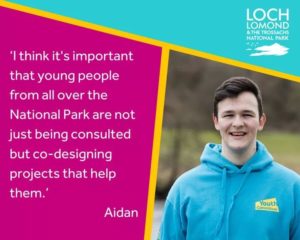
Aidan Cronin is a dedicated member of the Youth Committee
“In 2018 Scotland celebrated the Year of Young People. This was a big all year event supported by lots of organisations with an interest in Young People. The Loch Lomond and The Trossachs National Park (LLTNP) created the opportunity for Young People who live in or around the National Park to get involved with the Park. But this wasn’t the first time the National Park connected with young people. One of the first youth programmes the National Park undertook was their Junior Ranger programme in 2015. The Programme started as a week long adventure around the park for High School pupils. Meeting and working with rangers and partner organisations. The programme has now grown to involve more schools and now features a weekend programme for young people who have completed the school based programme.
Unfortunately, our Youth Committee just missed out on contributing to the EUROPARC Youth Manifesto, but we have made good use of it; we discussed it at one of our very first meetings. Many of the issues, if not all, are faced by young people in our Park.
The [EUROPARC Youth] Manifesto has worked as a great stage to build off of.
For example we have done a lot of work on Youth Empowerment by contributing ideas to wider projects, talking at Park Board meetings and co-designing projects like a photo competition.”
How many people are active in the Youth Committee? Who can become part of it?
“The group currently includes about 8 young people of varying ages, many currently of high school age. Anyone who lives in or around the National Park can get involved and we want to encourage more people to join. The Youth Committee are keen to get a wider range of young people from more places in and around the Park. Everyone on the committee brings their own ideas and passions to the table.”
What kind of activities do you undertake?
“The Youth Committee gets involved in lots of different ways. We have lots of opportunities to give feedback on Park wide issues such as Littering. We get to attend Park Board meetings to hear and discuss issues in the Park. We have presented our own board paper to the board which helped solidify the Youth Committees role and impact on the Park. The Youth Committee also has opportunities to work with other young people, like our Youth Volunteers and Junior Rangers. Lastly, we get to work with partner organisations and events, such as volunteering at the 2018 European Championships in Glasgow. We get up to a lot!”
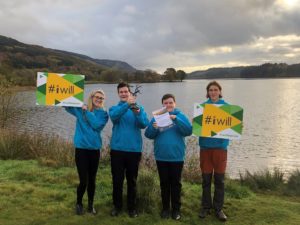
Loch Lomond Youth Committee receive the Best Engagement Project award at the UK National Parks Conference
How has corona impacted your work? Any post-corona plans for the Youth Committee?
“We had hoped to build on many of our successes from the year previous. However, it was not all bad news. The pandemic forced us to slow down, giving us a chance to think about what we want to do as a committee. The National Park staff supported us by meeting virtually. During the Lockdown we planned and sent out a survey to Young People across the park asking how they interacted with the park during Lockdown and what their priorities were for nature.
We want to grow in numbers, bringing on board more young people with a passion for the outdoors who can bring their stories and viewpoints to the committee. Climate change and how young people can contribute to this will be a key focus.”
What Youth Committee achievement are you most proud of?
“For many on the Youth Committee our achievement we are most proud of would be the experiences we’ve had. We had the opportunity in 2019 to go down to the Peak District National Park to meet with other young people from other UK National Parks, a great weekend full of discussions and activities. We are also proud that early doors, in 2019, we achieved Best Engagement Project at the UK National Parks Conference, which we were particularly proud to have achieved just 1 year after establishing the Youth Committee.”
Why do you believe it is important to involve youth in Protected Areas? What are the benefits?
“Protected Areas for the most part are in rural areas. These areas have unique challenges such as lack of transportation, internet connection and job opportunities. These challenges often push people out of rural areas, even though these areas may be of particular beauty. Allowing young people, the opportunity to shape and engage with Protected Areas allows for interest in rural jobs as well as sharing issues with people who can help fix them. It’s also important as young people are the ones who will be looking after Protected Areas in the future.”
How do you think Protected Areas can best involve young people?
“Many people, not just young people, are sometimes unaware of what and where Protected Areas are. Our recent survey found only 48.7% had a good understanding of the National Park, so there is a lot more that we can do to promote and engage young people. Protected Areas should create youth programmes which promote youth engagement with the outdoors, like Junior Rangers and Youth Committees.
Working collaboratively, Protected Areas and young people should seek to co-design solutions and projects.
What do you think needs to change in order to draw more young people to nature conservation? What are the obstacles/challenges now?
“The digitally connected world has pushed us inside, especially working from home and online school. Schools are using more and more technology, which is super important in our world today, but schools should also promote going outdoors. In our recent survey, 81% of young people agreed that schools should encourage more outdoor and nature education.
Our survey identified some key barriers young people felt when exploring the national park. 30% said transport to the area was the main barrier, with 24% saying lack of information was another barrier along with 12% saying a lack of equipment stopped them exploring the national park.”
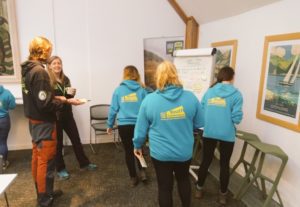
The Youth Committee at a meeting
What do you think is the most important skill young people need if they want to work for nature?
“Passion! With any job or volunteering enjoying it is important to staying motivated and interested.”
What is your tip to other young people in Europe that want to contribute to a more sustainable world?
“Start, even if it’s a small step. We live in a world with many issues, and it can become overwhelming at first. Picking one specific issue and focusing on it makes it easier to stay on track. Another way to contribute is through spreading awareness in your area. For example, starting an eco-group at school or writing to representatives. If you are lucky enough to live in a National Park, getting involved with them is also a great way to contribute.”
And finally: what makes the Loch Lomond National Park special and worth protecting?
“It’s hard to pick one, for many of the Youth Committee we have lived in the park our whole lives so that definitely plays a part in why the park is special. Everyone who works with the National Park (Volunteers, staff and partners) recognise that investing time, money and energy into conserving our landscape for future generations of people and animals is extremely important.
It is also very rewarding to step back and be able to say ‘I’ve contributed to something that other people can enjoy for years to come”.”
EUROPARC strongly supports the involvement of youth on all levels of Park management, be it through the Junior Ranger and Youth+ Programmes, or by adapting the Youth Manifesto. So of course we were excited to learn about this active group of youngsters in Scotland. Is your Protected Area giving a voice to young people? Then we would love to hear from you! Get in touch with us under communications@europarc.org & be sure to tag us and use the #StrongerWithYouth when posting on Social media.
This year’s EUROPARC Conference will feature a workshop dedicated to Youth Involvement. Find all info and registration here!
LIFE e-Natura2000.edu: Guidelines for replicability – summary edition
Over three years, six European partners have worked together to design and test new approaches to build and develop the capacities of Natura 2000 professionals.
From this experience, the main conclusions and recommendations for future competence-based learning initiatives are shared in this summary.
About the project
LIFE e-Natura2000.edu ran from April 2018 to July 2021. During that time, the project’s partners explored the potential of developing new approaches and integrating innovative learning methods to improve knowledge and capacity amongst Natura 2000 managers in both public and private land. The main aim of the project was to produce and test a flexible mix of blended learning tools and methods, designed to build and develop the capacity required for effective Natura 2000 management practices.
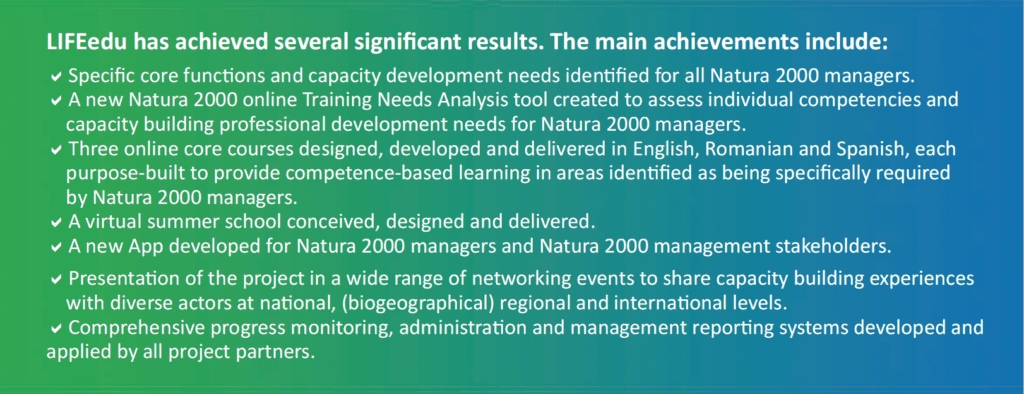
Knowing the training needs
The Training Needs Assessment (TNA) tool developed by LIFEedu is designed to help individual Natura 2000 managers to self-assess their competencies and training needs: they can use the results to learn about their priority capacity development needs and to better plan their future professional development actions.
In addition, two specific actions were implemented to explore various means of broadening the circle of officers, managers, professionals, stakeholders, and landowners potentially involved in the project: a specific Smartphone App and a university-based Virtual Summer
School.
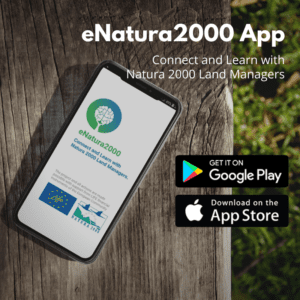
eNatura2000 App
The app is available on Google Play and App Store! DOWNLOAD IT NOW!
Delivering the courses
The project’s competence-based approach was based on identifying and assessing those competencies specifically required for the effective management of Natura2000 sites and projects. This was used to inform the development of tailor-made courses and their content, which were central to the project’s objectives and its implementation:
- Course I, Applied Conservation Biology, led by Propark and addressed mainly to Romanian Natura 2000 managers (in Romanian).
- Course II, Building Alliances for Natura 2000 Management, led by FUNGOBE and addressed mainly to Spanish Natura 2000 managers (in Spanish).
- Course III, Competent Inclusive Communication, led by EUROPARC and pan European in its scope (in English).
Capacity building is about building the professional capacity of people by encouraging them to engage themselves in a lifelong learning process by using diverse learning modes.
Take a look at a brief guide on how to build a short course:
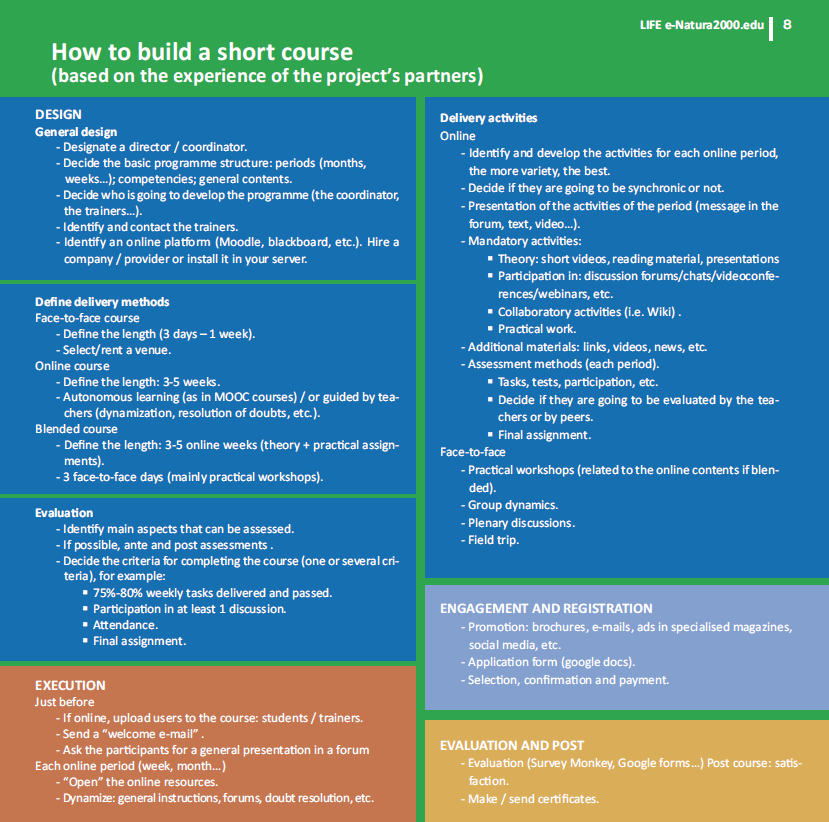
As a LIFE Preparatory project, a key goal for LIFEedu was to make its methods and results available to all interested in ways to improve the effectiveness of Natura 2000 management. To this end, a large number of networking actions, both formal and informal, have been completed throughout the project in local, national and international forums. Special attention was also given to the production of a consistent set of reporting deliverables, which guarantee that detailed and coherent information on all actions and results is available for future reference.
LIFEedu has evidenced the opportunities and merits of developing dedicated capacity building programmes, tailored for Natura 2000 professionals and designed to support the achievement of EU priorities for nature. As a direct outcome of the project, the value of creating continuous professional development programmes directly linked to EU priorities for nature has been demonstrated.
You can download the summary version of Guidelines for replicability here: LIFEedu Summary Replicability Guidelines
and the full version here: Guidelines for replicability and recommendations for future capacity building
LIFE e-Natura2000.edu: After-LIFE Plan
LIFE e-Natura 2000.edu was an innovative three-year project which explored new tools and learning methods to improve knowledge and build practical capacity amongst Natura 2000 managers. This After-LIFE Action Plan describes the project’s approach and specifically the six ambitious and interconnected implementation actions.
About LIFE e-Natura 2000.edu
Taking a competence-based approach, LIFEedu focused on capacity building for Natura 2000 managers and enabled peers to connect and learn about what managers need to know and be able to do. The project analysed training needs and created new tools and approaches to access information and learning about the skills required for effective Natura 2000 management and policy implementation.
The main objectives were:
- To demonstrate the need for and value of competence-based learning opportunities for Natura 2000 professionals through innovative learning methods and formats.
- To have developed and tested new tools for online learning that would improve and increase capacity building opportunities.
- To have created momentum for and demonstrated the value of a larger scale follow-up project.
The project was developed in response to the European Union’s Action Plan for Nature, People and Economy. The Action Plan was adopted following a thorough evaluation of the Birds and Habitats Directives, the so-called ‘Fitness Check’. The evaluation demonstrated that there was and continues to be an urgent need to pick up the pace of Natura 2000 implementation by improving the quality of management practices and the effectiveness of nature conservation objectives and measures.
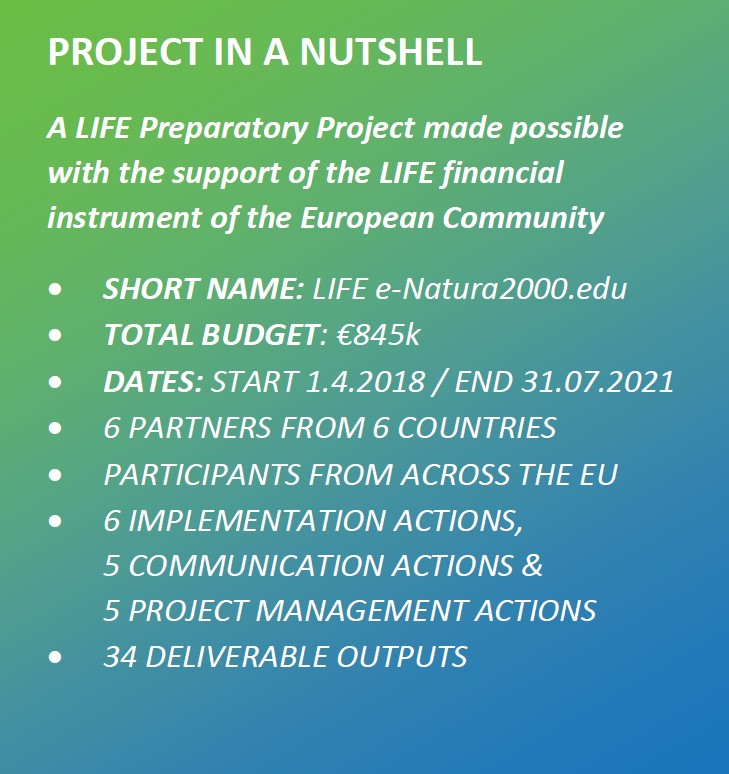
Why was LIFEedu necessary?
Natura 2000 sites and protected areas need to be proactively managed in ways that address site-specific conservation management needs and objectives, as well as the ambitions of the Natura 2000 network and the effective management of species and habitats of Community interest.
There is no ‘one size fits all’ approach for conservation in Europe.
What do we mean by capacity building?
Capacity building is the process by which individuals (and organisations) obtain, improve, and retain the skills, knowledge, tools, equipment and other resources needed to do their jobs competently. The focus in the LIFEe-Natura2000.edu project was on building Natura 2000 site managers’ capacity to do their work better, smarter and more efficiently.
What do we mean by a competence-based approach?
Competence-based approaches to capacity building are based around proven acquisition of the skills, knowledge and attitude required for effective implementation of tasks and functions.
Within the context of this LIFE Preparatory project, the competence-based approach to capacity building refers to providing learning opportunities that enable Natura 2000 site managers to develop or acquire the skills, knowledge and attitude needed to effectively perform tasks required of them by the Nature Directives.
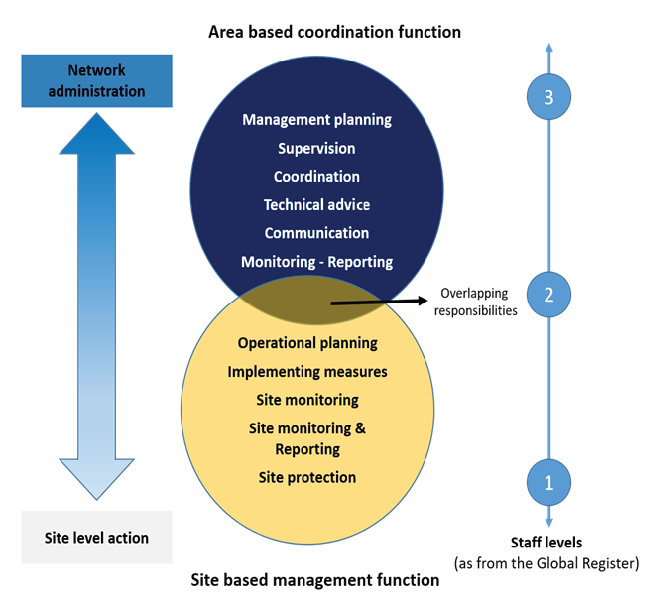
Competent Natura 2000 managers: Natura 2000 core functions
What do we mean by blended learning?
There is an increasing need to reach greater numbers of nature conservation professionals and to use new technologies and develop online learning. Our blended learning approach enabled participants to learn together in a variety of settings, where they interact with each other, share experiences, apply knowledge gains and work towards practical solutions for their Natura 2000 management challenges. At all times, the focus in the project was on generating maximum impacts at local levels by empowering Natura 2000 managers to improve their management practices.
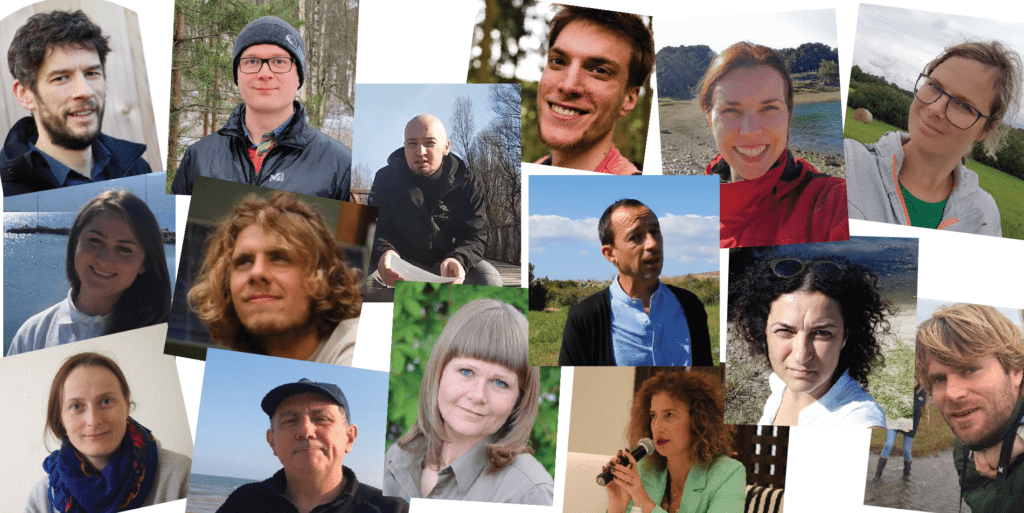
The participants of the course “Competent Inclusive Communication”, led by the EUROPARC Federation
LIFEedu’s Implementation Actions
LIFEedu involved six integrated implementation actions to create and test new tools and approaches for competence-based capacity building for Natura 2000 managers.
The project aimed to close the gaps between the ‘what’ and ‘how’ of Natura 2000 management, and provided a range of blended learning experiences across three core competence modules, which covered:
- Biodiversity conservation, policy, planning & project management skills – led by the ProPark Foundation in Romania
- How to work & collaborate effectively with local communities and respect cultural traditions – led by FUNGOBE in Spain
- How to communicate confidently about & advocate for Natura 2000 – led by the EUROPARC Federation in English
The range of delivery tools developed and tested within LIFEedu included:
- Webinars
- Demonstration videos
- Filmed ‘master class’ tutorials
- Workshops
- A ‘Natura 2000 in Practice’ Summer school
- New smartphone app – ‘virtual (twinning) hub’
- Practical assignments designed to:
- Analyse best practices to understand why they work;
- Apply learning & replicate where useful
- Think through problems to develop workable solutions
Evaluating experience
Based on the experience of the participants and how they applied their learning in practical ways, the project was able to gather evidence about what capacity gains participants felt they had achieved and would be, as a result of the project, able to adapt and apply with confidence.
Future plans
The LIFEe-Natura2000.edu project holds valuable lessons for all engaged in protecting Europe’s nature.
The project has demonstrated that:
There are common needs and competence-based learning opportunities specifically required for effective nature management in a variety of settings and operating contexts.
In future, the aim is to increase that potential and develop new approaches for individual and organisational capacity building, required to meet the major challenges impacting Europe’s nature in the 21st century. This involves investing in professional capacity building programmes to make sure that our current and future nature management professionals and their organisations have the specific competencies they need to do their work and protect our natural world.
To get more details and see the legacy and main outcomes of the LIFEedu project from different perspectives, download the full version of the document here: LIFEe-Natura2000.edu: After-LIFE Plan
